文章目录
Knife4j
Knife4j是基于springboot构建的一个文档生成工具,它可以让开发者为我们的应用生成API文档,目的是可以更加方便的基于API文档进行测试,生成的文档还可以导出,然后给到前端开发团队,前端开发团队可以基于API接口写具体的调用。
1 Knife4j的优点
- Knife4j 功能强大,易于操作。
- Knife4j 的UI界面非常美观,使用非常流畅。
- Knife4j 可以高度定制化,让其符合你的项目需求,提升用户体验。
- Knife4j 的支持性比较好,可以满足大部分的开发需求。
2 Knife4j快速上手(掌握基本应用即可)
2.1 pom.xml添加依赖
在你的SpringBoot项目的pom.xml文件中,添加如下依赖:
<!--添加Knife4j依赖--><dependency><groupId>com.github.xiaoymin</groupId><artifactId>knife4j-openapi2-spring-boot-starter</artifactId><version>4.1.0</version></dependency>
2.2 配置Swagger的相关信息
工程目录下创建config.Knife4jConfig
packagecn.tedu.weibo.config;importorg.springframework.context.annotation.Bean;importorg.springframework.context.annotation.Configuration;importspringfox.documentation.builders.ApiInfoBuilder;importspringfox.documentation.builders.PathSelectors;importspringfox.documentation.builders.RequestHandlerSelectors;importspringfox.documentation.service.ApiInfo;importspringfox.documentation.spi.DocumentationType;importspringfox.documentation.spring.web.plugins.Docket;importspringfox.documentation.swagger2.annotations.EnableSwagger2WebMvc;@Configuration@EnableSwagger2WebMvcpublicclassKnife4jConfig{//对于配置类要求可以看懂即可,不用反复去写,将来可以CV//配置Swagger2的Docket的Bean实例@BeanpublicDocketcreateRestApi(){returnnewDocket(DocumentationType.SWAGGER_2)// apiInfo():配置 API 的一些基本信息,比如:文档标题title,文档描述description,文档版本号version.apiInfo(apiInfo())// select():生成 API 文档的选择器,用于指定要生成哪些 API 文档.select()// apis():指定要生成哪个包下的 API 文档.apis(RequestHandlerSelectors.basePackage("cn.tedu.weibo.controller"))// paths():指定要生成哪个 URL 匹配模式下的 API 文档。这里使用 PathSelectors.any(),表示生成所有的 API 文档。.paths(PathSelectors.any()).build();}privatestaticfinalString API_TILE="微博项目";//文档信息配置privateApiInfoapiInfo(){returnnewApiInfoBuilder()// 文档标题.title(API_TILE)// 文档描述信息.description("微博项目在线API文档")// 文档版本号.version("1.0").build();}}
2.3 查看生成的接口文档
在 SpringBoot 项目启动后,访问
http://localhost:8080/doc.html
地址即可查看生成的Knife4j接口文档。
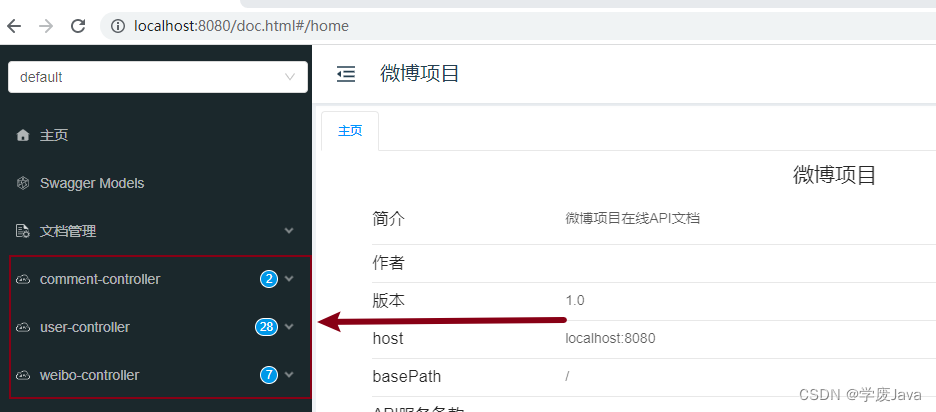
3 常用注解应用分析
- @Api注解添加在控制器类上的注解,通过此注解的tags属性可以修改原本显示控制器类名称的位置的文本,通常,建议在配置的tags属性值上添加序号,例如:“01. 用户模块”、“02. 微博模块”,则框架会根据值进行排序。- 参数说明- tags:配置模块名称- 代码示例
// 1. UserController@Api(tags ="01.用户管理模块")publicclassUserController{...}// 2. WeiboController@Api(tags ="02.微博管理模块")publicclassWeiboController{...}// 3. CommentController@Api(tags ="03.评论管理模块")publicclassCommentController{...}- 文档效果(重启工程并刷新页面:http://localhost:8080/doc.html#/home)
- @ApiOperation注解添加在控制器类中处理请求的方法上的注解,用于配置此方法处理的请求在API文档中显示的文本。- 参数说明- value:配置业务名称- 代码示例此处以注册功能为例,其他所有方法请添加说明
/**注册功能*/@RequestMapping("reg")@ApiOperation(value ="注册功能")publicintreg(@RequestBodyUserRegDTO userRegDTO){...}- 文档效果(重启工程并刷新页面:http://localhost:8080/doc.html#/home)
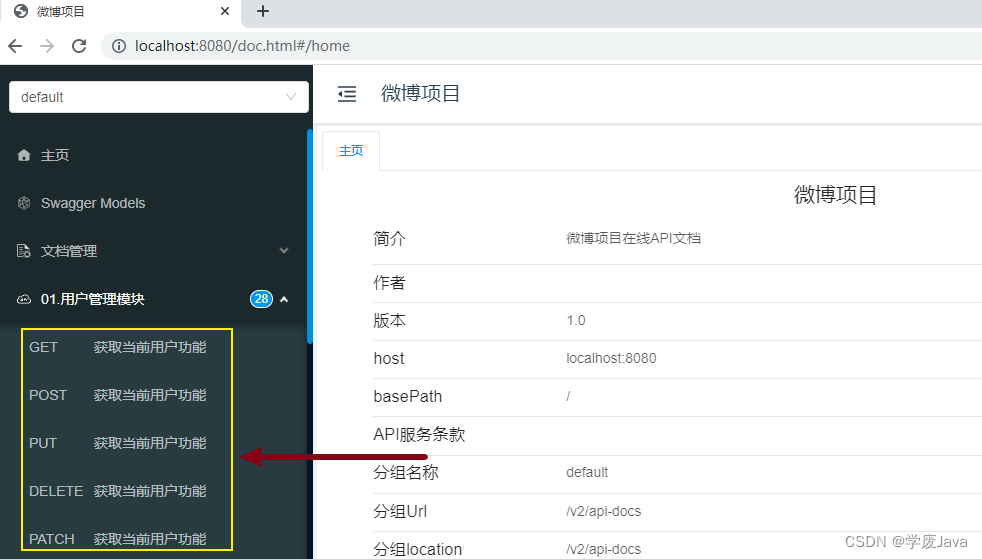
@ApiModelProperty注解是添加在POJO类的属性上的注解,用于对请求参数或响应结果中的某个属性进行说明, 主要通过其value属性配置描述文本,并可通过example属性配置示例值。- 参数说明- value属性:配置参数名称- required属性:配置是否必须提交此请求参数- example属性:配置示例值注意:如果配置了 required=true,只是一种显示效果,Knife4j框架并不具备检查功能- 代码示例以注册功能UserRegDTO为例
@DatapublicclassUserRegDTO{@ApiModelProperty(value ="用户名", required =true, example ="赵丽颖")privateString username;@ApiModelProperty(value ="密码", required =true)privateString password;@ApiModelProperty(value ="昵称", required =true)privateString nickname;}- 文档效果(重启工程并刷新页面:http://localhost:8080/doc.html#/home)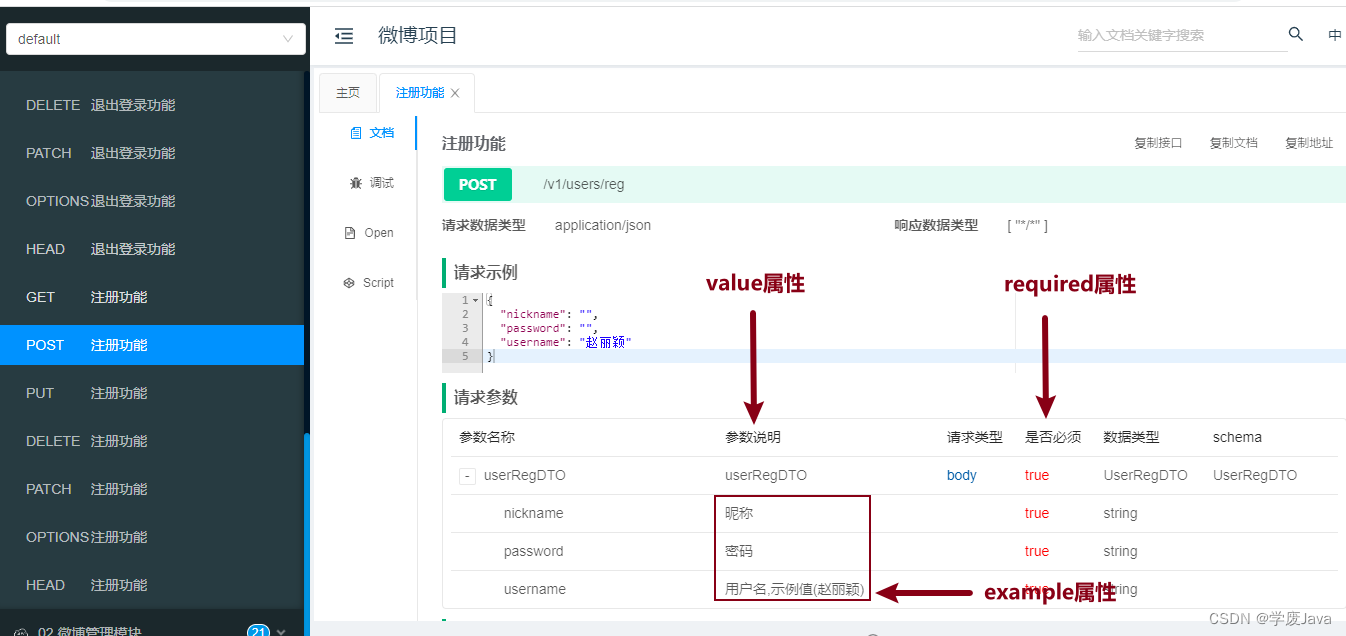
@ApiImplicitParam注解添加在控制器类中处理请求的方法上的注解,主要用于配置非封装(非XxxDTO/XxxParam的参数)的参数- 参数说明- name:指定参数名称(参数变量名)- value:配置参数名称- dataType:配置数据类型- required:配置是否必须提交此请求参数- example:配置参数的示例值注意:一旦使用此注解,各个参数的数据类型默认都会显示String,可以通过dataType指定数据类型- 代码示例此处以微博详情功能为例
@ApiImplicitParam(name ="id", value ="微博", required=true, dataType ="int")publicWeiboDetailVOselectById(int id){...}- 文档效果(重启工程并刷新页面:http://localhost:8080/doc.html#/home)
@ApiImplicitParams注解添加在控制器类中处理请求的方法上的注解,当方法有多个非封装的参数时,在方法上添加此注解,并在注解内部通过@ApiImplicitParam数组配置多个参数。- 代码示例此处以微博详情功能为例
/**微博详情页功能*/@GetMapping("selectById")@ApiOperation(value ="微博详情功能")@ApiImplicitParams(value ={@ApiImplicitParam(name ="id", value ="微博", required=true, dataType ="int"),@ApiImplicitParam(name ="username", value ="用户名", required=true)})// 额外增加username参数,仅仅用于测试publicWeiboDetailVOselectById(int id,String username){return weiboMapper.selectById(id);}- 文档效果(重启工程并刷新页面:http://localhost:8080/doc.html#/home)![[外链图片转存失败,源站可能有防盗链机制,建议将图片保存下来直接上传(img-DyWFaTEZ-1685759106118)(./images/image-20230513235042077.png)]](https://img-blog.csdnimg.cn/7a002f18400045acade3d3c37abc8875.png)
@ApiIgnore注解添加在处理请求的方法的参数上,用于表示API文档框架应该忽略此参数此处以发布微博功能的HttpSession参数为例- 代码示例
// 参数中添加@ApiIgnore注解publicintinsert(@RequestBodyWeiboDTO weiboDTO,@ApiIgnoreHttpSession session){...}- 文档效果(重启工程并刷新页面:http://localhost:8080/doc.html#/home)
4 限制请求方式
API文档中默认每个功能会展示7种请求方式,遵循RESTful规则将
@RequestMapping
注解修改为对应请求方法的注解,比如:
@GetMapping @PostMapping @PutMapping @DeleteMapping
注解,重启工程后刷新测试。
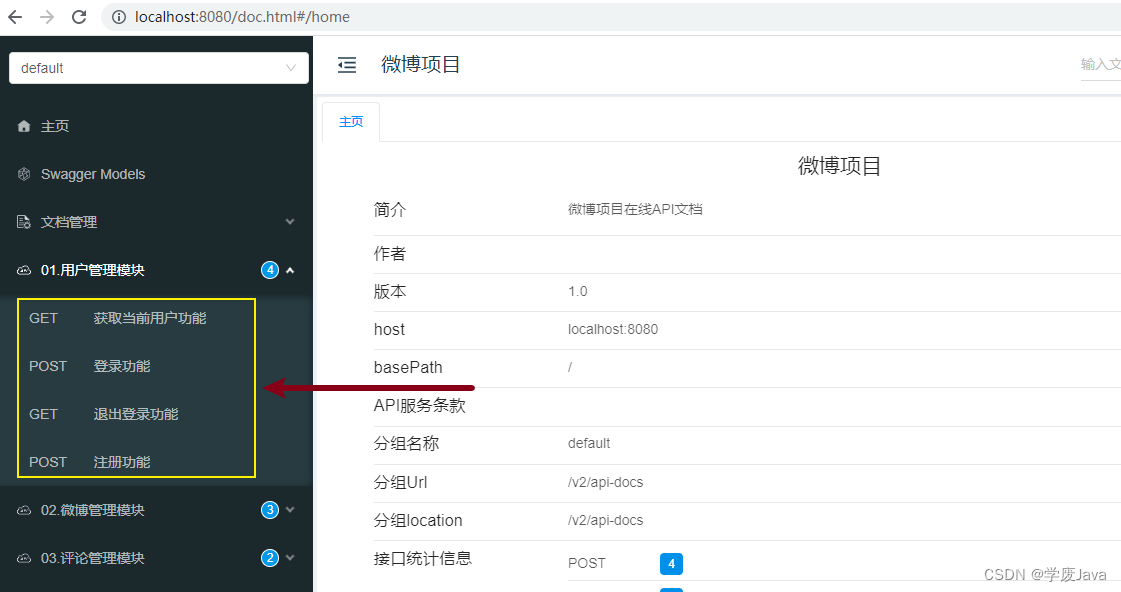
5 导出离线API文档
- 文档管理 - 离线文档 中存在多种格式的导出格式
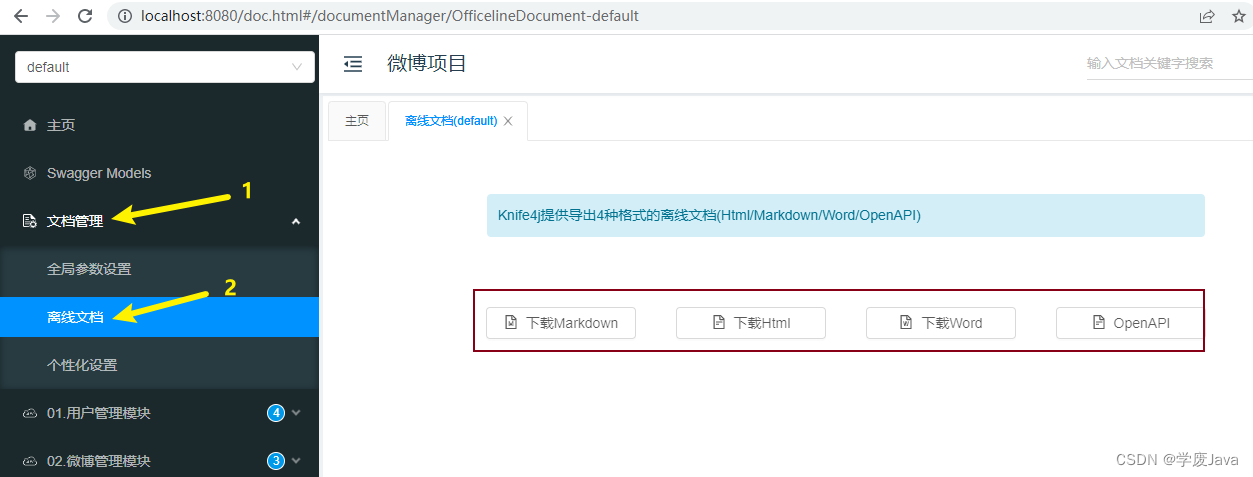
- 选择合适的文档格式,导出即可到本地磁盘
6 洞悉Knife4j生成API文档原理 (了解)
- 自定义注解(模拟Knife4j中注解的定义)
@Retention(RetentionPolicy.RUNTIME)@Target(ElementType.FIELD)@interfaceApiProperty{//interface,默认继承Annotation接口Stringvalue();booleanrequired();Stringexample()default"";}
2.通过注解描述类上属性
classPointDto{@ApiProperty(value ="x轴坐标",required =true,example ="10")privateint x;@ApiProperty(value ="y轴坐标",required =true,example ="10")privateint y;}
3.通过反射获取注解内容
publicclassAnnotationTests{@TestpublicvoiddoTest()throwsNoSuchFieldException{//获取PointDto类型的字节码对象(反射起点就是字节码对象)Class c1=PointDto.class;//获取PointDao类型中的x属性(通过反射获取)Field x=c1.getDeclaredField("x");//获取x属性上的ApiProperty注解(通过反射获取)ApiProperty annotation = x.getAnnotation(ApiProperty.class);//获取注解中value等属性的值String value = annotation.value();String example = annotation.example();System.out.println(value+"/"+example);}}
4.通过html/css/js构建页面(doc.html)
版权归原作者 学废Java 所有, 如有侵权,请联系我们删除。